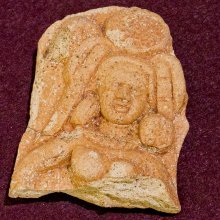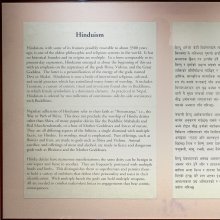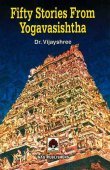Nari, Nārī, Nāri, Nāṟī: 28 definitions
Introduction:
Nari means something in Buddhism, Pali, Hinduism, Sanskrit, Jainism, Prakrit, Marathi, Hindi, biology, Tamil. If you want to know the exact meaning, history, etymology or English translation of this term then check out the descriptions on this page. Add your comment or reference to a book if you want to contribute to this summary article.
Images (photo gallery)
In Hinduism
Purana and Itihasa (epic history)
Source: archive.org: Puranic EncyclopediaNārī (नारी).—A daughter of Meru. She and her sisters were married by the following sons of Agnīdhra, i.e. Nābhi, Kimpuruṣa, Hari, Ilāvṛta, Ramyaka, Hiraṇmaya, Kuru, Bhadrāśva and Ketumāla. (Bhāgavata, 5th Skandha).
Source: archive.org: Shiva Purana - English TranslationNārī (नारी) refers to “women”, according to the Śivapurāṇa 2.3.9.—Accordingly, as Menā said to Himācala (Himavat):—“As but is natural to women [i.e., nārī-svabhāvata], the words of the sage have not been understood by me well. (I think it is better) that you perform the marriage of our daughter with a handsome bridegroom. Let the bridegroom of Pārvatī be born of a good family endowed with good characteristic signs. In every respect that marriage will yield an unprecedented happiness. Obeisance to you. Do everything necessary to make our daughter, as beloved to us as our own lives, very happy and delighted after being united with a good bridegroom”.
Source: Cologne Digital Sanskrit Dictionaries: The Purana IndexNārī (नारी).—A daughter of Meru and queen of Kuru.*
- * Bhāgavata-purāṇa V. 2. 23.

The Purana (पुराण, purāṇas) refers to Sanskrit literature preserving ancient India’s vast cultural history, including historical legends, religious ceremonies, various arts and sciences. The eighteen mahapuranas total over 400,000 shlokas (metrical couplets) and date to at least several centuries BCE.
Jyotisha (astronomy and astrology)
Source: Wisdom Library: Brihat Samhita by VarahamihiraNarī (नरी) refers to a “maiden”, according to the Bṛhatsaṃhitā (chapter 12), an encyclopedic Sanskrit work written by Varāhamihira mainly focusing on the science of ancient Indian astronomy astronomy (Jyotiṣa).—Accordingly, “I shall now expound about the movements of the Seven Ṛṣis (Saptarṣi), through whom the northern region shines as though bedecked with a pearl necklace, like a maiden with a smiling countenance wearing a garland of white lotuses. Or by the direction of her lord—the Pole-Star (Seven Ṛṣis), the northern maiden (quarter) appears to dance round [i.e., narī-nartī] as the Seven Ṛṣis move in their course. I begin to treat of these stars adopting the views of Vṛddha Garga”.

Jyotisha (ज्योतिष, jyotiṣa or jyotish) refers to ‘astronomy’ or “Vedic astrology” and represents the fifth of the six Vedangas (additional sciences to be studied along with the Vedas). Jyotisha concerns itself with the study and prediction of the movements of celestial bodies, in order to calculate the auspicious time for rituals and ceremonies.
Shaktism (Shakta philosophy)
Source: Brill: Śaivism and the Tantric Traditions (shaktism)Nārī (नारी) refers to “women (on earth)”, according to Sāhib Kaul’s Śārikāstrotra.—Accordingly, “[...] He who remembers your next syllable, which is īśa with abja, vahni, and padma, is remembered by goddesses in heaven, Nāga maidens in the netherworld, and women (nārī) on earth confused by the arrows of Kāma. One of pure mind who recites with complete devotion the lakṣmī-syllable, which is difficult for bad people to obtain, him the goddess of good fortune will always be eager to see, and although unsteady (by nature) she will remain at his doorstep out of devotion. [...]”.

Shakta (शाक्त, śākta) or Shaktism (śāktism) represents a tradition of Hinduism where the Goddess (Devi) is revered and worshipped. Shakta literature includes a range of scriptures, including various Agamas and Tantras, although its roots may be traced back to the Vedas.
Shaivism (Shaiva philosophy)
Source: Brill: Śaivism and the Tantric TraditionsNārī (नारी) (Cf. Strī) refers to “women”, according to the 13th-century Matsyendrasaṃhitā: a Kubjikā-Tripurā oriented Tantric Yoga text of the Ṣaḍanvayaśāmbhava tradition from South India.—Accordingly, “Contempt [for these] will make him fall immediately here in this world and in the other world, O Pārvatī. He should not follow the path of the paśus [i.e. that of the uninitiated] and he should not long for the leftover of paśus. He should strive for an encounter with the Yoginīs. He should not have sex with uninitiated women. He should not give leftovers to the uninitiated. He should never abuse women (nārī). [...]”.

Shaiva (शैव, śaiva) or Shaivism (śaivism) represents a tradition of Hinduism worshiping Shiva as the supreme being. Closely related to Shaktism, Shaiva literature includes a range of scriptures, including Tantras, while the root of this tradition may be traced back to the ancient Vedas.
In Buddhism
Theravada (major branch of Buddhism)
Source: Pali Kanon: Pali Proper NamesOne of the palaces occupied by Tissa Buddha in his last lay life. Bu.xviii.17; BuA (188) calls it Narisa.
Theravāda is a major branch of Buddhism having the the Pali canon (tipitaka) as their canonical literature, which includes the vinaya-pitaka (monastic rules), the sutta-pitaka (Buddhist sermons) and the abhidhamma-pitaka (philosophy and psychology).
Tibetan Buddhism (Vajrayana or tantric Buddhism)
Source: academia.edu: The Structure and Meanings of the Heruka MaṇḍalaNārī (नारी) is the name of a Ḍākinī who, together with the Vīra (hero) named Nāracakravartin forms one of the 36 pairs situated in the Kāyacakra, according to the 10th century Ḍākārṇava chapter 15. Accordingly, the kāyacakra refers to one of the three divisions of the nirmāṇa-puṭa (emanation layer’), situated in the Herukamaṇḍala. The 36 pairs of Ḍākinīs [viz., Nārī] and Vīras are body-word-mind-color (mixture of white, red, and black); they each have one face and four arms; they hold a skull bowl, a skull staff, a small drum, and a knife.

Tibetan Buddhism includes schools such as Nyingma, Kadampa, Kagyu and Gelug. Their primary canon of literature is divided in two broad categories: The Kangyur, which consists of Buddha’s words, and the Tengyur, which includes commentaries from various sources. Esotericism and tantra techniques (vajrayāna) are collected indepently.
In Jainism
General definition (in Jainism)
Source: Wisdom Library: JainismNārī (नारी) is the name of a river mentioned as flowing through Ramyaka together with the Narakāntā river. Ramyaka is one of the seven regions (kṣetra) of Jambūdvīpa according to Jaina cosmology. Jambūdvīpa sits at the centre of madhyaloka (‘middle world’) is the most important of all continents and it is here where human beings reside.
Source: Encyclopedia of Jainism: Tattvartha Sutra 3: The Lower and middle worldsNārī (नारी) is the name of a river that, coupled with the Narakāntā river, separates the Ramyaka region. Ramyaka refers to one of the regions of Jambūdvīpa: the first continent of the Madhya-loka (middle-word), according to the 2nd-century Tattvārthasūtra 3.10. The Nārī river flows eastwards. The Nārī and Narakāntā rivers and have 56000 tributaries.
Jambūdvīpa (where flows the Nārī river) is in the centre of all continents and oceans; all continents and oceans are concentric circles with Jambūdvīpa in the centre. Like the navel is in the centre of the body, Jambūdvīpa is in the centre of all continents and oceans. Sumeru Mount is in the centre of Jambūdvīpa. It is also called Mount Sudarśana.

Jainism is an Indian religion of Dharma whose doctrine revolves around harmlessness (ahimsa) towards every living being. The two major branches (Digambara and Svetambara) of Jainism stimulate self-control (or, shramana, ‘self-reliance’) and spiritual development through a path of peace for the soul to progess to the ultimate goal.
Biology (plants and animals)
Source: Google Books: CRC World Dictionary (Regional names)1) Nari in India is the name of a plant defined with Ipomoea aquatica in various botanical sources. This page contains potential references in Ayurveda, modern medicine, and other folk traditions or local practices It has the synonym Convolvulus reptans L. (among others).
2) Nari is also identified with Mikania cordata It has the synonym Eupatorium cordatum Burm.f. (etc.).
Example references for further research on medicinal uses or toxicity (see latin names for full list):
· Flora Indica (1768)
· Cytologia (1992)
· Species Plantarum (1753)
· Contributions from the Gray Herbarium of Harvard University (1934)
· Investigatio et Studium Naturae (1992)
· Proceedings of the Indian Science Congress Association (1984)
If you are looking for specific details regarding Nari, for example pregnancy safety, diet and recipes, health benefits, extract dosage, side effects, chemical composition, have a look at these references.

This sections includes definitions from the five kingdoms of living things: Animals, Plants, Fungi, Protists and Monera. It will include both the official binomial nomenclature (scientific names usually in Latin) as well as regional spellings and variants.
Languages of India and abroad
Pali-English dictionary
Source: BuddhaSasana: Concise Pali-English Dictionarynārī : (f.) a woman.
Source: Sutta: The Pali Text Society's Pali-English DictionaryNārī, (f.) (Sk. nārī to nara man, orig. “the one belonging to the man”) woman, wife, female Sn. 301, 836; Dh. 284; J. I, 60; III, 395; IV, 396 (°gaṇa); Vv 61, 4416; Pv. I, 91 (=itthi PvA. 44). pl. nariyo (Sn. 299, 304, 703), & nāriyo (Sn. 703 v. l. BB; Pv. II, 952). combined with nara as naranārī, male & female (angels), e.g. Vv 538; Pv. II, 112 (see nara). (Page 350)

Pali is the language of the Tipiṭaka, which is the sacred canon of Theravāda Buddhism and contains much of the Buddha’s speech. Closeley related to Sanskrit, both languages are used interchangeably between religions.
Marathi-English dictionary
Source: DDSA: The Molesworth Marathi and English Dictionarynarī (नरी).—f ( H) Goatskin dressed (for shoes &c.)
--- OR ---
narī (नरी).—f S A woman.
--- OR ---
nārī (नारी).—f (S) A woman or female.
Source: DDSA: The Aryabhusan school dictionary, Marathi-Englishnarī (नरी).—f Goatskin dressed (for shoes &c.)
--- OR ---
narī (नरी).—f A woman.
--- OR ---
nārī (नारी).—f A woman or female.
Marathi is an Indo-European language having over 70 million native speakers people in (predominantly) Maharashtra India. Marathi, like many other Indo-Aryan languages, evolved from early forms of Prakrit, which itself is a subset of Sanskrit, one of the most ancient languages of the world.
Sanskrit dictionary
Source: DDSA: The practical Sanskrit-English dictionaryNarī (नरी).—A woman; नम्या नरीभिरमरीव हि सा विरेजे (namyā narībhiramarīva hi sā vireje) Bv.3.16.
--- OR ---
Nārī (नारी).—[nṝ-nara-vā jātau ṅīṣ ni°]
1) A woman; अर्थतः पुरुषो नारी या नारी सार्थतः पुमान् (arthataḥ puruṣo nārī yā nārī sārthataḥ pumān) Mṛcchakaṭika 3.27.
2) Any female or feminine object.
3) Sacrifice.
Source: Cologne Digital Sanskrit Dictionaries: Shabda-Sagara Sanskrit-English DictionaryNārī (नारी).—f. (-rī) 1. A woman in general, a female. 2. A species of the Madhya metre. E. nara a man, añ and ṅīp affs. or nṛ + nara + vā jātau ṅīṣ nipātane .
Source: Cologne Digital Sanskrit Dictionaries: Benfey Sanskrit-English DictionaryNārī (नारी).—see nāra.
Source: Cologne Digital Sanskrit Dictionaries: Cappeller Sanskrit-English DictionaryNāri (नारि).—[feminine] = nārī.
--- OR ---
Nārī (नारी).—v. nāra.
Source: Cologne Digital Sanskrit Dictionaries: Monier-Williams Sanskrit-English Dictionary1) Narī (नरी):—[from nara] a f. a woman (= nārī), [cf. Lexicographers, esp. such as amarasiṃha, halāyudha, hemacandra, etc.]
2) [from nara] b in [compound] for ra.
3) Nārī (नारी):—[from nāra] a f. See nārī
4) Nāri (नारि):—[from nāra] f. = nārī below.
5) Nārī (नारी):—[from nāra] b f. (of ra q.v.) a woman, a wife (in older language also nāri), [Ṛg-veda] etc. etc.
6) [v.s. ...] a female or any object regarded as feminine, [Vājasaneyi-saṃhitā; Taittirīya-āraṇyaka]
7) [v.s. ...] sacrifice, [Naighaṇṭuka, commented on by Yāska]
8) [v.s. ...] Name of a daughter of Meru, [Bhāgavata-purāṇa]
9) [v.s. ...] of 2 kinds of metre, [Colebrooke]
10) c f. See above.
Source: Cologne Digital Sanskrit Dictionaries: Yates Sanskrit-English DictionaryNārī (नारी):—(rī) 3. f. A woman in general.
Source: DDSA: Paia-sadda-mahannavo; a comprehensive Prakrit Hindi dictionary (S)Nārī (नारी) in the Sanskrit language is related to the Prakrit word: Ṇārī.
[Sanskrit to German]
Sanskrit, also spelled संस्कृतम् (saṃskṛtam), is an ancient language of India commonly seen as the grandmother of the Indo-European language family (even English!). Closely allied with Prakrit and Pali, Sanskrit is more exhaustive in both grammar and terms and has the most extensive collection of literature in the world, greatly surpassing its sister-languages Greek and Latin.
Hindi dictionary
Source: DDSA: A practical Hindi-English dictionaryNārī (नारी):—(nf) a woman; (a) female; -[upāsanā] geneolatory; —[dveṣa] misogymy.
...
Prakrit-English dictionary
Source: DDSA: Paia-sadda-mahannavo; a comprehensive Prakrit Hindi dictionaryṆārī (णारी) in the Prakrit language is related to the Sanskrit word: Nārī.
Prakrit is an ancient language closely associated with both Pali and Sanskrit. Jain literature is often composed in this language or sub-dialects, such as the Agamas and their commentaries which are written in Ardhamagadhi and Maharashtri Prakrit. The earliest extant texts can be dated to as early as the 4th century BCE although core portions might be older.
Kannada-English dictionary
Source: Alar: Kannada-English corpusNari (ನರಿ):—
1) [noun] the wild dog Canis aureus, (smaller than the wolf), which often hunt prey in pack at night and eat carrion and cretin plants, believed to be sly; jackal.
2) [noun] the large, fierce Asian cat, Panthera tigris, having a tawny coat striped with black; a tiger.
3) [noun] a subtly deceitful, cunning person.
4) [noun] ನರಿಕೂಗು ಗಗನ ಮುಟ್ಟೀತೆ [narikugu gagana muttite]? nari kūgu gagana muṭṭīte? (prov.) the voice of poor and underprivileged, is never heard in the society; ನರಿಯ ಬುದ್ಧಿ [nariya buddhi] nariya buddhi craftiness; slyness; cunningness; ನರಿ ಮುಖ ನೋಡಿರು [nari mukha nodiru] nari mukha nōḍiru (fig.) to be very fortunate.
--- OR ---
Nāri (ನಾರಿ):—
1) [noun] the string of a bow.
2) [noun] the fibrous web at the bottom of a coconut leaf-stalk.
--- OR ---
Nāri (ನಾರಿ):—
1) [noun] an adult human being; a woman.
2) [noun] ಒಲಿದರೆ ನಾರಿ, ಮುನಿದರೆ ಮಾರಿ [olidare nari, munidare mari] olidare nāri, munidare māri she who bestows favour when friendly, can annihilate when enraged.
--- OR ---
Nāri (ನಾರಿ):—[noun] he who is foe-less; a man having no enemy.
Kannada is a Dravidian language (as opposed to the Indo-European language family) mainly spoken in the southwestern region of India.
Tamil dictionary
Source: DDSA: University of Madras: Tamil LexiconNari (நரி) [narital] 4 transitive verb < நலி-. [nali-.] To torture, torment; வருத்துதல். அரியுந்தசை தீற்றி நரியுந் தொறும் [varuthuthal. ariyunthasai thirri nariyun thorum] (காஞ்சிப்புராணம் இருபத்தெண். [kanchippuranam irupathen.] 365).
--- OR ---
Nari (நரி) [narittal] 11 verb cf. நரி. [nari.] intransitive To be foxy; நரித்தன்மையடைதல். நரிகா ணரியாது நீர் . . . நுங்குரல்காட்டும் [narithanmaiyadaithal. nariga nariyathu nir . . . nunguralkattum] (திருவாலவாயுடையார் திருவிளையாடற் [thiruvalavayudaiyar thiruvilaiyadar] 28, 12). — transitive To deride, despise; நித்தித்தல். ((சங்கத்தகராதி) தமிழ்சொல்லகராதி) [nithithal. ((sangathagarathi) thamizhsollagarathi)]
--- OR ---
Nari (நரி) [narittal] 11 verb cf. நெரி-. [neri-.] transitive
1. To torment; வருத்துதல். திருச்சிராப்பள்ளி யென் றலுந் தீவினை நரிச்சிராது [varuthuthal. thiruchirappalli yen ralun thivinai narichirathu] (தேவாரம் [thevaram] 369, 3).
2. To crush; நொறுக்குதல். (யாழ்ப்பாணத்து மானிப்பாயகராதி) [norukkuthal. (yazhppanathu manippayagarathi)] — intransitive To perish; கெடுதல். கருத்தீமை நரிச்சு நீங்க [keduthal. karuthimai narichu ninga] (காஞ்சிப்புராணம் வாணீ. [kanchippuranam vani.] 111).
--- OR ---
Nari (நரி) noun [Malayalam: nari.]
1. [Telugu: nariyaḍu, K. Travancore usage nari.] Jackal; சிறுவிலங்குவகை. காலாழ் களரி னரியடும் [siruvilanguvagai. kalazh kalari nariyadum] (திருக்குறள் [thirukkural], 500).
2. Tiger; புலி. [puli.] (W.) Cant.
3. A contrivance made of straw with a fox-like tail, for draining off water in a field after transplantation; நாற்றுப் பாவின மறுநாள் நீர் வடியும்படி கட்டியிழுக்கும் நரிவாலுருவமான வைக் கோற்புரிக் கருவி. [narrup pavina marunal nir vadiyumbadi kattiyizhukkum narivaluruvamana vaig korpurig karuvi.] Nāñ.
--- OR ---
Nāri (நாரி) noun perhaps from நார். [narrinai]
1. [Telugu: K. nāri.] Bowstring; வில்லின் நாணி. நாரியின் பேரொலி [villin nani. nariyin peroli] (கந்தபு. தாரக. [kanthapu. tharaga.] 142).
2. [K. nāri.] Fibrous covering at the bottom of a leaf-stalk, as of a cocoanut palm; பன்னாடை. (பிங்கலகண்டு) [pannadai. (pingalagandu)]
3. Lute-string; யாழ் நரம்பு. [yazh narambu.] (W.)
4. Loins, hips; இடுப்பு. [iduppu.] (J.)
--- OR ---
Nāri (நாரி) noun
1. cf. நார் [narrinai] + அரி. [ari.] Toddy; கள். (பிங்கலகண்டு) [kal. (pingalagandu)]
2. Honey; தேன். (உரிச்சொல்நிகண்டு) [then. (uricholnigandu)]
--- OR ---
Nāri (நாரி) noun < நன்னாரி. [nannari.] Indian sarasaparilla. See நன்னாரி. (தைலவருக்கச்சுருக்கம் தைல.) [nannari. (thailavarukkachurukkam thaila.)]
--- OR ---
Nāri (நாரி) noun < nārī.
1. Woman; பெண். (பிங்கலகண்டு) நாரிய ரில்லையிஞ் ஞாலமேழு மென்ன [pen. (pingalagandu) nariya rillaiyign gnalamezhu menna] (கம்பராமாயணம் கைகேசிசூழ். [kambaramayanam kaigesisuzh.] 22).
2. Pārvatī பார்வதி. (பிங்கலகண்டு) [parvathi. (pingalagandu)]
3. Army; சேனை. (யாழ்ப்பாணத்து மானிப்பாயகராதி) [senai. (yazhppanathu manippayagarathi)]
--- OR ---
Nāri (நாரி) noun < நாறு-. [naru-.] Odour, fragrance; வாசனை. [vasanai.] (W.)
--- OR ---
Nāṟī (நாறீ) [nāṟi] noun < nārī cf. kumārī. Aloe. See கற்றாழை. (வைத்திய மலையகராதி) [karrazhai. (vaithiya malaiyagarathi)]
--- OR ---
Nāri (நாரி) [nāṟi] noun cf. நாரி³. [nari³.] See நன்னாரி. ((சங்கத்தகராதி) தமிழ்சொல்லகராதி) [nannari. ((sangathagarathi) thamizhsollagarathi)]
--- OR ---
Nari (நரி) [narittal] 11 intransitive verb To be perplexed; பிரமித்தல். [piramithal.] Pond.
Tamil is an ancient language of India from the Dravidian family spoken by roughly 250 million people mainly in southern India and Sri Lanka.
See also (Relevant definitions)
Starts with (+244): Nari baalada honne, Nari draakshi balli, Nari hesara, Nari hesaru, Nari mullu, Nari murup, Nari payaru, Nari siris, Nari-aandolan, Nari-andolana, Nari-baalada-gandu-hullu, Nari-baalada-honne, Nari-eerulli, Nari-hernu, Nari-ilantai, Nari-irulli, Nari-kabbu, Nari-kamonmada, Nari-kela, Nari-kera.
Ends with (+185): Ajirnari, Alankanari, Amettiyanari, Anari, Antkinari, Anyanari, Aranari, Ardhanari, Asanari, Atikanari, Attainari, Attanari, Aushinari, Baihinari, Bakaininari, Bakarinari, Banari, Bandunari, Bhatala-penari, Bheterinari.
Full-text (+300): Nariprasanga, Naritarangaka, Narishtha, Nariyana, Narika, Naridushana, Narivali, Narishta, Nari-andolana, Nari-ilantai, Narikkuttu, Nari-kamonmada, Mutta-nari, Narimaya, Taramgaka, Nishantanari, Nari-aandolan, Kulanari, Kridanari, Puranari.
Relevant text
Search found 57 books and stories containing Nari, Nārī, Nāri, Narī, Ṇāri, Ṇāri°, Ṇārī, Nāṟī, Naari, Naaree; (plurals include: Naris, Nārīs, Nāris, Narīs, Ṇāris, Ṇāri°s, Ṇārīs, Nāṟīs, Naaris, Naarees). You can also click to the full overview containing English textual excerpts. Below are direct links for the most relevant articles:
Rig Veda (translation and commentary) (by H. H. Wilson)
Tattvartha Sutra (with commentary) (by Vijay K. Jain)
Verse 3.20 - The rivers dividing the regions < [Chapter 3 - The Lower World and the Middle World]
Verse 3.22 - The direction of the remaining rivers < [Chapter 3 - The Lower World and the Middle World]
Verse 3.23 - The tributaries of the rivers < [Chapter 3 - The Lower World and the Middle World]
Garga Samhita (English) (by Danavir Goswami)
Verse 4.11.10 < [Chapter 11 - The Story of the Gopīs that were Residents of...]
Verse 4.19.49 < [Chapter 19 - A Thousand Names of Srī Yamunā]
Verse 4.19.24 < [Chapter 19 - A Thousand Names of Srī Yamunā]
Manusmriti with the Commentary of Medhatithi (by Ganganatha Jha)
Verse 4.41 < [Section IX - Personal Cleanliness]
Verse 3.138 < [Section VIII - Śrāddhas]
Verse 1.32 < [Section XVIII - Creation of the Male and the Female]
Mudrarakshasa (literary study) (by Antara Chakravarty)
2.1. Use of Sragdharā metre < [Chapter 4 - Employment of Chandas in Mudrārākṣasa]
2.12. Use of Pṛthvī metre < [Chapter 4 - Employment of Chandas in Mudrārākṣasa]
Chaitanya Bhagavata (by Bhumipati Dāsa)
Verse 2.12.10 < [Chapter 12 - The Glories of Nityānanda]
Verse 1.3.13 < [Chapter 3 - Calculation of the Lord’s Horoscope]
Verse 3.5.460 < [Chapter 5 - The Pastimes of Nityānanda]
Related products






